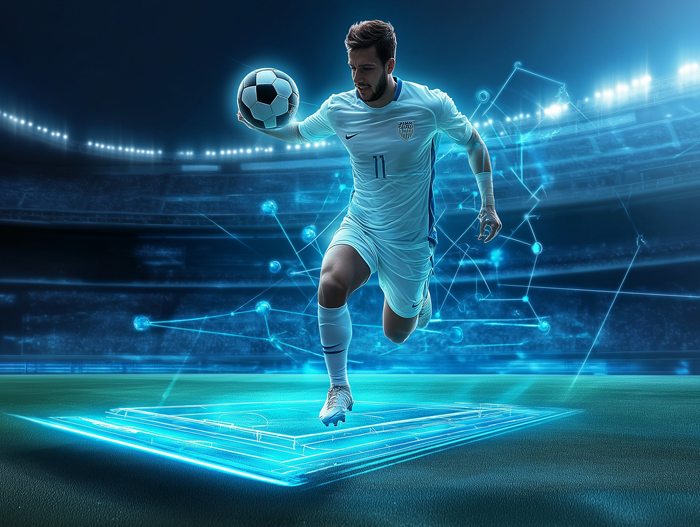Introduction
Sports have been an integral part of human civilization for centuries, evolving from simple competitive activities to highly sophisticated and technologically advanced spectacles. Over the years, advancements in technology have revolutionized how athletes train, how games are played, and how fans engage with their favorite sports.
From instant replay systems to wearable fitness trackers, technology has transformed nearly every aspect of sports, making games faster, fairer, and more exciting than ever before. This article explores the impact of technology on sports, highlighting how it has reshaped training, officiating, fan engagement, and overall game strategies.
1. Wearable Technology & Performance Analytics
Athlete performance has significantly improved with the introduction of wearable technology and advanced data analytics.
•Smart Wearables: Devices like WHOOP bands, Fitbit, and Garmin smartwatches help monitor heart rate, oxygen levels, and exertion, allowing athletes to optimize their training.
•GPS Trackers: Many sports teams use GPS vests to track player movements, analyze stamina, and adjust strategies based on real-time data.
•Biomechanics Sensors: Sensors embedded in equipment or uniforms analyze an athlete’s form, balance, and efficiency, leading to better injury prevention and recovery methods.
These technologies help athletes and coaches make data-driven decisions, improving overall performance and longevity.
2. Video Technology & Instant Replay
One of the most significant advancements in sports technology is instant replay and video-assisted refereeing (VAR), which ensures fairness and accuracy in officiating.
•VAR (Video Assistant Referee) – Used in soccer to review controversial decisions, including goals, penalties, and fouls.
•Hawk-Eye Technology – Employed in tennis, cricket, and soccer, this system provides real-time ball tracking to determine whether a shot was in or out.
•NFL Instant Replay – Football referees use multiple camera angles to review touchdowns, fumbles, and out-of-bounds plays.
These advancements reduce human errors, ensuring that crucial decisions are made with maximum precision.
3. Smart Equipment & AI-Driven Coaching
Technology has also transformed sports equipment, making it more precise, efficient, and customizable for each athlete.
•Smart Basketballs & Soccer Balls – Brands like Wilson and Adidas have introduced sensor-equipped balls that track spin, speed, and accuracy, providing athletes with immediate feedback.
•AI-Powered Coaching Systems – Artificial intelligence helps coaches analyze player performance through machine learning algorithms, offering personalized training programs.
•Smart Rackets & Clubs – Tennis rackets and golf clubs now come with built-in sensors to measure swing speed, impact, and technique, helping players fine-tune their skills.
These innovations enhance training and give athletes a competitive edge.
4. Fan Experience & Augmented Reality (AR)
Technology is not just improving how sports are played but also how they are experienced by fans.
•Augmented Reality (AR) & Virtual Reality (VR) – AR apps allow fans to view player stats in real-time, while VR simulations let users experience games as if they were on the field.
•Smart Stadiums – Venues like SoFi Stadium in Los Angeles feature 5G connectivity, cashless transactions, and real-time seat upgrades for a seamless fan experience.
•Live Streaming & AI Commentary – Advanced camera angles, automated commentary, and multi-angle replays enhance the way fans watch games from home.
These innovations make sports more interactive and engaging, bringing fans closer to the action.
5. Sports Medicine & Injury Prevention
Technology has also played a critical role in sports medicine, helping athletes recover faster and stay in peak condition.
•Cryotherapy & Hyperbaric Chambers – Athletes use cold therapy and oxygen-rich environments to speed up recovery.
•AI Injury Prediction – Machine learning can analyze movement patterns and predict injuries before they happen, allowing teams to adjust training loads.
•3D-Printed Prosthetics – Paralympic athletes benefit from custom-made prosthetics and exoskeletons, giving them a level playing field.
With these medical advancements, athletes can extend their careers and reduce the risk of serious injuries.
6. Esports & the Future of Virtual Competition
The rise of esports (competitive video gaming) has blurred the lines between traditional sports and digital competition. Games like League of Legends, FIFA, and Call of Duty now have professional leagues, sponsorships, and multimillion-dollar prize pools.
•VR & Motion Tracking – New gaming setups allow realistic movement tracking, making esports more physically interactive.
•AI Opponents & Training Bots – Athletes and gamers alike use AI-driven opponents for practice, improving reaction times and decision-making.
•Metaverse Integration – Virtual sports arenas and digital avatars could shape the future of fan engagement in ways never seen before.
Esports is expanding rapidly, proving that digital sports are becoming just as influential as traditional physical sports.
Conclusion
Technology has redefined sports in almost every way, from training and performance tracking to officiating and fan experiences. As AI, VR, and biomechanics continue to advance, we can expect even greater transformations in the future.
Whether you’re an athlete, coach, or fan, technology is enhancing the way we experience and interact with sports—making them more precise, engaging, and exciting than ever before. The evolution is far from over, and the next wave of innovations could change the game forever.

The Evolution of Sports: How Technology Is Changing the Game
990
previous post




